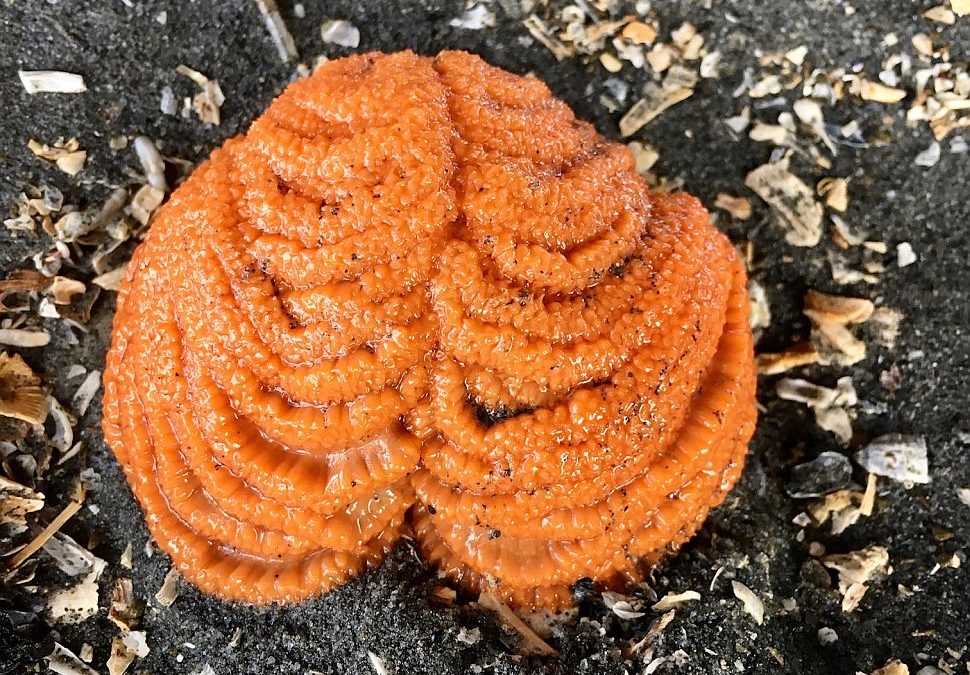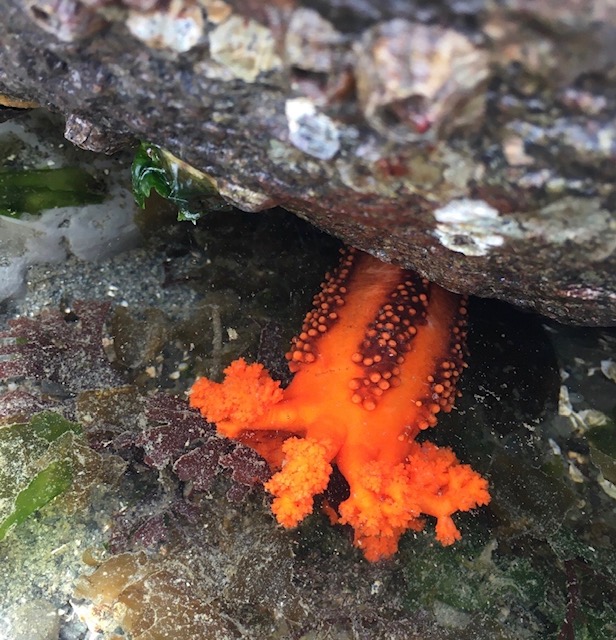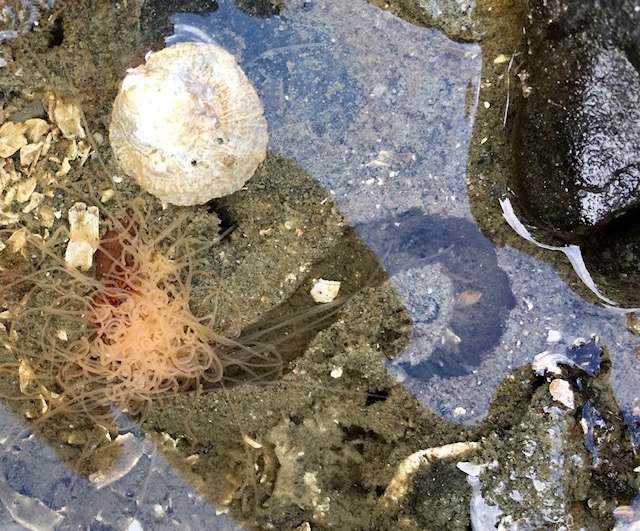Every low tide I am seized by conflicting emotions of joyful anticipation and looming dread. I am excited by the prospect of entering the temporarily drained and accessible octopuses’ gardens—to walk among the sea pens I can usually only discern in a watery blur from the ferry dock 20 feet up, to encounter the moonsnail laying her hundreds of thousands of eggs in a round sand collar, to wonder up close at the incandescent glow of a striped nudibranch.
I am equally horrified by the fact that I am King Kong—and these beach beings the vulnerable Fay Wrays at the mercy of my thundering gumboot steps. I worry as I walk in the shallows that I may be breaking those living beneath. Think of it—turning over a head-sized rock at the shore is like the giant ape ripping your house from its foundation and flipping it roof-down to examine the curiosities of your daily living!
The low-tide weekend earlier in May provided the perfect weather for exploration, and there were far fewer crushing bootsteps due to COVID-19. Still, I found a disturbing number of upturned boulders dotting the north-end shoreline. Their undersides exposed the intricate self-constructed sand-tube homes of spaghetti worms, dark-loving creatures with a pasta-like tangle of tentacles (that can grow to a meter in length!) left to cower in the sun. Burrowing sea cucumbers, their orange blooms retracted, were laid bare to the wind and sunlight. And tadpole-like clingfish exposed to the dry air.
How can we explore at the shore and be less like King Kong? Beach etiquette is like obeying your aunt’s house rules even if they are different from your own. Just like your aunt, each of the beings you encounter is an individual with preferences for meals, resting spots, and neighbors. They have complex lives and body systems (a spaghetti worm has muscles, nerves, and kidneys in each one of its segmented body parts; it cements sand and gravel together to make its own home; and it can lasso food with its uber-long tentacles!) So just like we would at our aunt’s place, we can adopt a few new house rules when we go on low-tide walks:
- Please don’t step on the eelgrass as it is a thriving nursery for young and soft-bodied creatures.
- Please don’t turn over a rock that’s bigger than your head, and always replace it gently after carefully examining those who reside beneath. Why not make it a challenge to just choose one rock to turn over? There is so much to see under the edges of larger rocks, in the clay holes created by clams, under the dock, and on pilings.
- Please don’t touch things with your bare hands—especially soft-bodied animals—as you likely carry soap, sunscreen, or sanitizer residue that can pollute vulnerable tissues. Leave limpets, chitons, and snails attached where you find them. Their home territory is as important to them as your neighborhood is to you. If you move them, they may die of exposure, be preyed upon, or never find their way home again.
Do take time to observe an intertidal resident in its habitat. Who is living nearby? Are they eating? Moving or at rest? Take a close-up photo of the rock or tidepool and examine it carefully when you get home—you may be surprised to find other animals who were hiding in plain sight.
The tides are going to be great for exploring again this week! I hope you discover a new intertidal denizen and share photos on our Facebook page or tag us on Instagram. And before you head out, consider taking the Beach Etiquette Pledge developed by the Vashon Beach Naturalists. In addition, Vashon Nature Center has also just completed our first Nearshore Resource Guide. This collates information on harvesting regulations, including where and how to report offenders, and offers tips on safe harvesting principles.
These are two easy ways we can help create a future with even more wondrous creatures to discover at the next low tide. Sharing this information shows everyone, from near and far, that Vashon beach life is cared for and a treasured part of our island community. Have fun on the beach!
Featured photo: Sea pen at north end ferry dock beach by: Kathryn True




Years back we had many sea pens, cucumbers, south Maury. I’m happyto know you can see them by the ferry dock.
I think it may be due to changes of water temperature ….rather than just chemicals in the bay although temp is never mentioned. Is it studied? Very LITTle garbage is now found these days on the beaches, at least one happy comment.